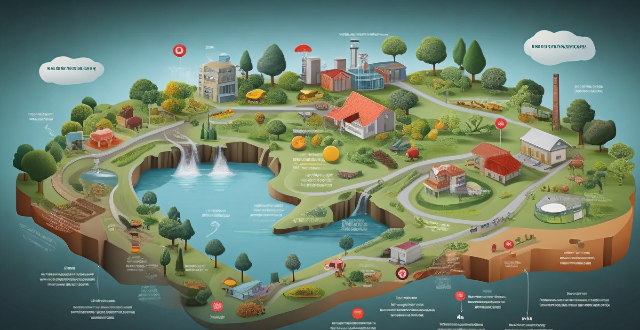Community Food

How do different regions around the world cope with climate change-related threats to their food sources ?
Coping with Climate Change: Global Strategies for Food Security explores how various regions are adapting agricultural practices to ensure food security amidst climate change. Asia is focusing on modernizing irrigation systems and researching drought-resistant crops. Africa is promoting small-scale farming techniques and agroforestry. Europe is utilizing precision farming and developing climate-smart crops. North America is practicing rotational grazing and using genetic engineering for more resilient crops. South America is embracing agroecology and community-based adaptation. Australia and Oceania are managing soil salinity issues and heat tolerance research. Policy initiatives include improving access to finance for smallholder farmers and establishing regulatory frameworks. Community-level actions involve farmer training programs and local innovations like community gardens. Technology adoption includes mobile apps for weather information and remote sensing for crop monitoring. The conclusion emphasizes the importance of combining traditional knowledge with modern technology to address climate change and ensure global food security.

What role do community gardens play in city greening efforts ?
Community gardens play a significant role in city greening efforts by providing environmental, social, economic, and urban planning benefits. These gardens improve air quality, enhance biodiversity, and promote soil health. They also foster community building, offer educational opportunities, and contribute to health promotion. Economically, community gardens provide food security and create job opportunities. Integrated into urban planning, they beautify cities and promote sustainable development. Overall, community gardens are vital for ecological health and improving residents' quality of life.

How can immigrants effectively integrate into a new community ?
Effective integration of immigrants into a new community involves learning the local language, engaging with the community, embracing cultural differences, building a support network, seeking out resources, and being patient and persistent. These strategies can help immigrants communicate effectively, find employment opportunities, understand the culture, make friends, and navigate the legal processes involved in immigration.

How does food tourism impact local economies and cultures ?
Food tourism, also known as culinary or gastronomy tourism, has significant impacts on local economies and cultures. Economic benefits include job creation, increased revenue for local businesses, tourism diversification, infrastructure development, and value addition to local products. Culturally, food tourism promotes the preservation of traditions, cultural exchange, heritage promotion, adaptation and innovation, and community engagement. However, there are potential downsides such as overcommercialization, resource depletion, and pricing issues that require careful management to ensure authenticity and sustainability.

How do food festivals impact tourism in a region ?
Food festivals significantly impact tourism in a region, offering economic benefits and promoting cultural exchange. They attract visitors, boost spending, create jobs, and support local businesses. Culinary diversity, community engagement, and media exposure enhance the region's brand image. Sustainability is crucial for supporting local farmers and managing waste. Successful examples include tomato, wine & cheese, and seafood festivals. Food festivals are powerful tools for driving tourism and enriching the travel experience.

How can we involve community members in climate adaptation planning ?
Community engagement is crucial for successful climate adaptation planning. To involve community members, identify and engage stakeholders, develop a stakeholder engagement plan, use multiple channels of communication, involve community members in decision making, provide training and education, foster partnerships and collaboration, and monitor and evaluate progress. By doing so, you can create a more resilient community that is better prepared for the impacts of climate change.

What are the best sources for buying organic food ?
The article discusses various sources for buying organic food, including farmers markets, online stores, health food stores, and community supported agriculture (CSA) programs. Each option has its own set of benefits and drawbacks, such as freshness, convenience, selection, cost, and support for local agriculture. The article emphasizes the importance of making healthy choices for oneself and family by choosing organic food.

How can we measure the effectiveness of community climate adaptation efforts ?
Measuring the effectiveness of community climate adaptation efforts is crucial for understanding their impact on resilience to climate change. Key steps include setting clear objectives, developing relevant indicators, collecting and analyzing data, transparent reporting, evaluating success, iterative improvement, community engagement, and policy alignment. By following these steps, communities can ensure their adaptation efforts are effective and continuously improved.

How do different cultures celebrate holidays with food ?
Food plays a significant role in various cultures around the world. Different cultures have unique ways of celebrating holidays with food. For example, during Chinese New Year, people enjoy dishes like dumplings (symbolizing wealth) and fish (representing abundance). In the United States, Thanksgiving is celebrated with turkey (symbolizing plenty), pumpkin pie (representing the harvest season), and stuffing/dressing (made with bread and herbs, signifying gratitude and fullness). Christmas is celebrated differently across the world, with traditions like Christmas Pudding in the United Kingdom, Roast Goose in Germany, and La Befana in Italy. Hanukkah is celebrated with latkes (potato pancakes representing resilience and joy) and sufganiyot (jelly-filled doughnuts symbolizing happiness and freedom). Eid al-Fitr is celebrated by breaking fast with dates (representing renewal and purity) and sharing sweets like baklava (symbolizing abundance and celebration). Diwali is celebrated with laddoo (ball-shaped sweets representing unity and happiness) and barfi (a fudge-like dessert symbolizing prosperity and delight). Food not only nourishes but also brings people together during holidays, expressing gratitude, sharing abundance, and strengthening community bonds through delicious meals and sweets.

How do sports events promote social interaction and community building ?
Sports events play a significant role in promoting social interaction and community building. They bring people together, foster a sense of belonging, and create opportunities for individuals to connect with one another. This is achieved through encouraging participation, building community spirit, providing entertainment and recreation, facilitating networking opportunities, and enhancing diversity and inclusion. By bringing people together around a shared passion for sports, these events create lasting connections and positive experiences that extend far beyond the playing field.

In what ways do women's empowerment initiatives contribute to community development ?
Women's empowerment initiatives are crucial for community development as they address gender inequalities and foster inclusivity. These initiatives benefit not only women but also have a positive ripple effect on the broader community, leading to more sustainable and equitable growth. Economic growth is achieved through increased participation in the workforce, entrepreneurship and innovation, and improved household economics. Social development is promoted through health and well-being, education, and gender equality. Political empowerment is enhanced through increased participation in decision-making and promotion of good governance. Environmental sustainability is ensured through resource management and climate action. Cultural preservation and exchange are enriched through artistic expression and cultural exchange. Women's empowerment initiatives are essential for comprehensive community development, addressing gender inequalities, promoting inclusivity, and paving the way for sustainable growth, social cohesion, and a brighter future for all members of the community.

How do sports initiatives support community health and wellbeing in cities ?
Sports initiatives in cities are crucial for promoting physical activity, social interaction, mental health, and overall quality of life. The collaboration between the International Olympic Committee and PATH is a prime example of how these initiatives can make a significant impact on community health. By increasing access to health-enhancing community sport activities, sports initiatives support physical activity, enhance social interaction, improve mental health, raise awareness about health issues, and contribute to economic impact and urban development. These initiatives are valuable investments for city planners and policymakers as they promote community health and wellbeing in urban areas.

What are some successful examples of sports-based community development initiatives ?
Sports-based community development initiatives have been successful in various parts of the world, bringing people together and fostering a sense of community. Some notable examples include Sport for Social Impact, Right to Play, Sport and Recreation Victoria, and Sport England. These organizations use sports to tackle social challenges such as poverty, gender inequality, lack of education, and physical inactivity. Their programs range from soccer games promoting peace in Israel and Palestine to after-school programs teaching life skills in areas affected by war, poverty, and disease. These examples demonstrate the power of sports-based community development initiatives to bring people together, promote health and well-being, and address social challenges.

How can we raise awareness about the importance of community climate adaptation ?
To raise awareness about the importance of community climate adaptation, several strategies can be employed: 1. **Education and Outreach Programs**: Conduct workshops, engage schools, collaborate with media outlets, and develop informational materials to educate people about climate change and its implications. 2. **Community Engagement Initiatives**: Encourage public participation in discussions, foster partnerships with local organizations, and promote civic leadership to drive climate adaptation efforts. 3. **Visual Aids and Creative Approaches**: Use art, performances, exhibits, infographics, and other creative means to communicate the importance of climate resilience. 4. **Online Platforms and Social Media**: Leverage digital tools like social media campaigns, online forums, virtual reality experiences, and interactive apps to reach a wider audience. 5. **Policy Advocacy and Support**: Advocate for favorable policies, provide financial incentives, and support legislation that enhances community resilience against climate change.

What role do sports organizations play in fostering community engagement and participation ?
The text discusses the role of sports organizations in fostering community engagement and participation. It highlights their contributions in various areas including community building, educational outreach, economic impact, and social responsibility. Sports organizations promote social interaction by offering memberships, organizing events, and providing volunteer opportunities. They enhance diversity and inclusion through inclusive policies, adaptive sports programs, and cultural celebrations. In terms of educational outreach, they promote health and wellness through fitness programs, workshops, and school collaborations. They also develop life skills such as leadership, character development, and career opportunities. Sports organizations stimulate local economies by hosting tournaments and events, promoting sports tourism, and creating jobs. They support local businesses through partnership programs, community marketplaces, and merchandise sales. Additionally, sports organizations demonstrate social responsibility by adopting green initiatives, planning eco-friendly events, launching educational campaigns, organizing fundraising events, having athlete ambassadors, and offering matching gift programs. Overall, sports organizations play a crucial role in building social connections, enhancing diversity and inclusion, providing educational outreach, stimulating local economies, and embracing social responsibility.

How important is composition in food photography ?
Composition is essential in food photography for creating visually appealing images. Techniques such as focusing on the subject, using negative space, incorporating leading lines, following the rule of thirds, and experimenting with color and contrast can enhance the visual appeal of food photographs.

What is the significance of traceability in the food supply chain for food safety ?
Traceability in the food supply chain is crucial for food safety, enhancing transparency, facilitating recalls, improving quality control, supporting regulatory compliance, enabling better risk management, and promoting sustainable practices.

How are food safety regulations enforced by governments ?
Governments around the world enforce food safety regulations through various methods, including legislation and policy development, inspection and compliance checks, licensing and certification, education and training, penalties and enforcement actions, public communication, and international cooperation. These efforts aim to protect consumers from harmful substances and contaminants in food products while promoting fair trade practices among producers and retailers.

What are the key principles of food safety ?
The text outlines the key principles of food safety, which include cleanliness, avoiding cross-contamination, thorough cooking, proper storage, and using safe water and ingredients. By following these guidelines, individuals can reduce the risk of foodborne illnesses and ensure that their meals are safe for consumption.

Can sports be used as a tool for social change and community development ?
This text discusses the potential of sports as a tool for social change and community development. It highlights how sports can break down barriers, promote health and well-being, and contribute to education and personal development. The article also explores how sports can address social issues, empower communities economically, and promote peace and reconciliation. However, it emphasizes the need for equitable resource allocation, accessibility, and sustainability to fully realize the potential of sports in societal transformation.

Can eating organic food prevent diseases ?
Eating organic food may offer some potential benefits for disease prevention, such as reduced exposure to pesticides and chemicals, higher antioxidant levels, and better nutrient content. However, the overall evidence supporting its ability to prevent diseases is limited, and other factors influencing disease risk should also be considered when making dietary choices. It is important to prioritize a balanced and varied diet rich in fruits, vegetables, whole grains, lean proteins, and healthy fats while minimizing intake of processed foods and sugary beverages.

How does food labeling contribute to food safety ?
Food labeling is crucial for food safety as it provides consumers with essential information. It includes ingredient lists, nutritional information, expiration dates, manufacturing details, storage instructions, certification marks, allergy warnings, country of origin, precautionary statements, and environmental impact information. Proper labeling practices help identify ingredients, understand nutritional values, recognize potential risks, and make informed decisions about food consumption.

How does climate change affect agriculture and food security ?
Climate change significantly affects agriculture and food security by increasing extreme weather events, altering crop yields and quality, impacting livestock, and raising concerns about food access, affordability, and biodiversity loss. Adaptation and mitigation strategies such as sustainable farming practices, water management, genetic research, and policy initiatives are essential to build a resilient food system.

How can I reduce food waste in my kitchen ?
To reduce food waste in your kitchen, you can plan meals ahead of shopping, shop smart by making a list and buying fresh produce, store foods properly using airtight containers, understand expiration dates, preserve food through techniques like freezing and dehydrating, get creative with leftovers, practice portion control, and educate yourself on the environmental impact of food waste.

How do street food vendors keep their food safe and hygienic ?
Street food vendors play a crucial role in providing affordable and delicious meals to millions of people worldwide. However, ensuring that their food is safe and hygienic can be challenging due to various factors such as limited space, lack of proper equipment, and unpredictable weather conditions. In this article, we will discuss some effective ways street food vendors can maintain the safety and cleanliness of their food.

How can urban planning and design contribute to enhancing urban food security under changing climatic conditions ?
The text discusses the importance of urban planning and design in enhancing food security in cities, especially under changing climatic conditions. It outlines key strategies such as promoting urban agriculture, sustainable land use planning, improving access to healthy food options, supporting local food production and consumption, and fostering innovation and collaboration. These strategies aim to create resilient and self-sufficient urban environments that can adapt to climate change while ensuring food security for all residents.

What role do sports clubs and community centers play in promoting public health initiatives ?
Sports clubs and community centers significantly contribute to public health efforts by offering programs and services that encourage physical activity, provide educational opportunities, build social support networks, target specific demographics, and collaborate with health organizations. These establishments play a crucial role in promoting healthier lifestyles through their facilities, workshops, group activities, youth and senior programs, and partnerships with hospitals and awareness campaigns. By catering to diverse age groups and interests, sports clubs and community centers help foster a culture of health and wellness within communities.

What impact does sports have on the social cohesion and community spirit in rural areas ?
The article discusses the impact of sports on social cohesion and community spirit in rural areas. Sports bring people together, promote teamwork, and create a sense of belonging that can strengthen the fabric of a community. The article explores how sports build social capital by forming friendships and encouraging civic engagement. It also highlights how sports promote teamwork and cooperation by teaching communication skills and collaboration towards a common goal. Finally, the article emphasizes how sports create a sense of belonging within a community by supporting local teams and participating in community events. Overall, sports have a significant impact on rural communities and contribute to their overall well-being.

Is organic food healthier than non-organic food ?
The debate over whether organic food is healthier than non-organic food has been ongoing for decades. While some argue that organic food offers more nutritional benefits and is better for the environment, others believe that the differences are negligible and that non-organic food can be just as healthy. In this article, we will explore both sides of the argument and try to answer the question: is organic food healthier than non-organic food? Arguments in favor of organic food include nutritional benefits, pesticide reduction, and environmental impact. Organic farming practices focus on building healthy soil and growing strong plants, which results in produce that is richer in nutrients like vitamins, minerals, and antioxidants. Additionally, organic food is grown without the use of synthetic pesticides and fertilizers, reducing the risk of harmful chemicals ending up in our food supply. Finally, organic farming practices promote biodiversity, reduce pollution, and help preserve natural resources. Arguments against organic food include minimal nutritional differences, low pesticide residues, and higher cost. While some studies have found that organic food is more nutritious than non-organic food, other research suggests that the differences are minimal. The levels of pesticides found in non-organic produce are generally well below what is considered safe by regulatory agencies, and washing produce thoroughly can further reduce pesticide residues. However, one of the biggest drawbacks of organic food is its higher cost compared to non-organic options. Ultimately, the decision of whether to choose organic or non-organic food depends on personal preference and individual circumstances. If you prioritize nutrition, reducing your exposure to pesticides, and supporting environmentally friendly farming practices, then organic food may be the way to go. However, if you are concerned about cost or believe that the nutritional differences between organic and non-organic food are minimal, then non-organic options may be suitable for you.

How can I gauge the level of parental involvement and community support at a school ?
Gauging the level of parental involvement and community support at a school is crucial for parents when choosing an educational institution for their child. This can significantly impact a student's academic performance and overall development. To gauge these factors, parents can observe school events, talk to other parents, and research the school's reputation. When observing school events, parents should attend open houses, sports games/concerts, and volunteer opportunities to assess the turnout and engagement of parents during these events. A high turnout and active participation suggest strong parental involvement and community support. Parents can also connect with other parents through social media groups, PTA meetings, school drop-off/pick-up times, and school events to ask about their experiences regarding parental involvement and community support at the school. Asking about their level of involvement, supportiveness of the school, communication channels, and impact on student performance can provide valuable insights. Researching the school's reputation online through reviews, rankings, news articles, social media, forums, and message boards can also help gauge parental involvement and community support. Analyzing historical data such as enrollment trends, fundraising results, alumni success rates, and school surveys/feedback can further indicate the level of these factors over time. In conclusion, gauging the level of parental involvement and community support at a school involves attending school events, talking to other parents, and researching the school's reputation. By doing so, parents can make informed decisions about choosing the right school for their child that fosters a supportive and engaging environment conducive to academic success and overall development.